
Centre of Jaina Studies Newsletter: SOAS - University of London
Years ago, Bhuvanendra Kumar, editor of the Jinamanjari (published in Canada, now defunct), gave me a copy of the first page of a letter, written on 11x14 paper, to decipher. It is written in Marathi in Moḍī (cursive) lipi, which was used mostly for correspondence and bookkeeping during the eighteenth century in Maharashtra (Figure 1). The subsequent pages, which would have given us the contents of the letter, are missing. Bhuvanendra Kumar has returned to India and is not available to answer questions about where he obtained it, or if he has more pages of this letter.
In December 2004 I sent this page to (the late) Subhāścandra Akkoḷe, editor of Sanmati Māsik at Bāhubali, to find someone at Kolhapur who could read it. He found an old brāhmaṇa paṇḍit able to reproduce it in Nāgarī. I have made a romanized copy of the same here for publication along with the original in Moḍi lipi (Figure 2).
This letter with two seals, one of the office of a bhaṭṭāraka and one of his name, together with its date (1870 CE) and its place of origin (Sātārā), is addressed by a bhaṭṭāraka to a large number of members of a single Jaina community, known as Kāsāra (kaṃsa-kāra= copper/ bronze-smith), living in Puṇe, Maharashtra. It is unique in the bhaṭṭāraka tradition because, to the best of my knowledge, it is the only extant letter from a bhaṭṭāraka to his lay disciples.
The letter begins:
From: Rājendrakīrti bhaṭṭārakapaṭṭācārya, the supreme head of the Balātkāragaṇa. To: the group [of Kāsāra-s], the dearest and foremost among his true (khare) disciples, all of whom (tamām) are devoted to the religion (dharma) of the Jinas.
This is followed by names of twenty-five such householders, serial numbers appearing before their names.
The letter continues:
To all Somavaṃśī Kṣatriya Kāsāras resident (mukkām) in Puṇe: auspicious blessings for the increase in your piety (dharma). Moreover, today, [our] stay [begins] here at Sātārā [south of Puṇe and north of Kolhapur, possibly for the four months (cāturmāsa) of retreat, during the rainy season] engaged in recitation of holy prayers and study of the scriptures. We wish constant spiritual welfare for your families. After this, from here [Sātārā], this letter to you, today, in the month of Āṣāḍha, fifth day of the bright half of the month, Śaka year 1792 (=1792+78=1870 CE).
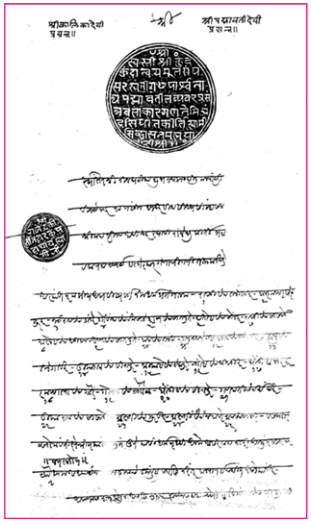
Figure 1. The original letter in Moḍī script. Photo courtesy of Bhuvanendra Kumar.
The letter ends on this page. The remaining pages are yet to be discovered.
Given the large number of wealthy Kāsāra merchants (Marathi seṭa-/seṭha-s) who are named, these pages might reveal a grand project (e.g., renovation of the old temples) of the Bhaṭṭāraka Rājendrakīrti, himself, most certainly, a Kāsāra Jaina, like several of his predecessors on the Malkhed-pīṭha.
I will now comment on a number of important points raised by this document regarding the official seals and the community to whom this letter is addressed.
Malayādri=Mānyakheṭa>Malayakheḍa>Malayādri> Malkhed
Nathuram Premi (1956: 229) gives a brief history of Malkhed, a village with two ruined Jaina temples, in the Gulbarga District of Karnataka state. Malkhed was the capital of the Rāṣṭrakūṭa King Kṛṣṇa III in 966 CE. Around this time, the famous (Śaiva turned) Jaina
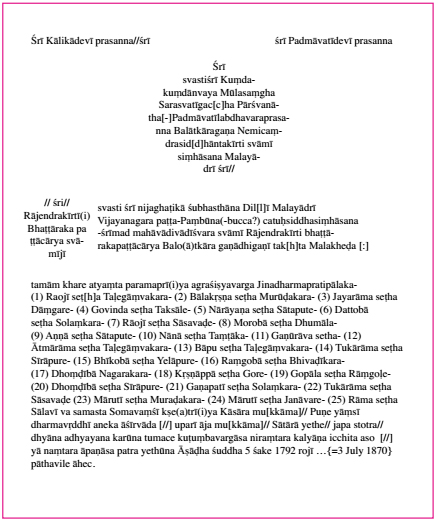
Figure 2. Transcription of Figure 1
poet Puṣpadanta, the author of the Apabhraṃśa Prakrit Mahāpurāṇa, mentions how this city (Mānyakheṭa/ Maṇṇakheḍa) was looted and burned by the Paramāra King Siyaka-Gurjararāja in Śaka 894 (=972 CE). However, there is no mention of a bhaṭṭāraka seat there in Puṣpadanta's works. Long after the reconstruction of the city, it was called Malayakheḍa, and according to Desai (2001: 323), in an inscription (1393 CE) at the Neminātha temple, it was called Malayādri. Now it is the small village called Malkhed.
Details Regarding the Balātkāragaṇa at Malkhed
According to Joharapurakar (1956: §§7374) the Balātkāragaṇa pīṭha was established in Karanja from the time of Bhaṭṭāraka Dharmabhūṣaṇa (early 18th century) onwards. Prior to this, the seat was located at Mānyakheḍa (Malayakheḍa). However, Detige (2015: 149) notes that it was established earlier: "According to Chavare, it was Bhaṭṭāraka Dharmacandra who established the Balātkāragaṇa-pīṭha in Karanja in saṃvat 1575 (=1518 CE), as the first branch of the Mānyakheḍapīṭha." Thus, the Balātkāragaṇa at Mānyakheḍa may go back to about 1400 CE.
Śrī Mūlasaṃgha-Balātkāragaṇa and the Change from Balakāra to Balātkāra
The Balātkāragaṇa as well as the Senagaṇa both call themselves Mūlasaṃgha. Sometimes the word Balātkāragaṇa is dropped; only Mūlasaṃgha is retained. Detige (2015: 148, n. 26) suggests: "The preference for Mūlasaṃgha elsewhere might also be dependent on the negative primary meaning of the word balātkāra in modern Hindi (violence, rape)."
It is unlikely that the learned Digambara Jains, both in the north and south, would not have been aware of such negative meanings of the word balātkāra, and yet they chose to use it. It is necessary to see if this name was newly adopted, in preference to the original Kannada name Baḷagāra, the meaning of which may have been forgotten.
I venture to suggest that instead of balātkāra the original word might have been balakāra = balagāra: from Skt. valaya-kāra = bracelet / bangle-maker and seller; Kannada baḷegāra, and according to Joharapurakar, there is inscriptional evidence in support of this, as discussed below.
In tenth-century Karnataka, there was a large community of Digambara Jains engaged in this business, in the neighborhood of Malkhed, notably at Mudhoḷ, 190 kilometers from Gulbarga. The Kannada Jain poet Ranna (=Ratna, 993 CE), in his Ajitatīrthaṅkara-purāṇa tilakam, calls himself a proud member of this baḷagāra community:
Beḷugare nāḍoḷ puṭṭida Baḷegārara kuladoḷ ereda Ajitaśāsanamaṃ/ beḷaguva cakreśvara ma- ṇḍaḷeśvaraṃ besase negaḷda kaviRatnaṃ//12.45.[1]
The famous (negaḷda) poet Ratnam (Ranna) was born in the Beḷugare province. He belonged to the caste (family) of Baḷegāra (bangle seller). He (Ranna) wrote the excellent (ereda) Ajitaśāsanamam (Ajita Tīrthaṅkara Purāṇa) on the command of the lustrous cakreśvara (emperor) and maṇḍaḷeśvara.
A community of baḷagaras, with a Jaina poet of such eminence, might also have produced Jaina munis who would travel north and would be known as munis of the Balagara/Balakara/Balakāra-gaṇa. For example, śrī Mūlasaṃghada Balakara-gaṇada; Baḷagara-gaṇada (Nagarajaiah 1998: 17).
Joharapurakar (1956: §89 and §91) states:
In old inscriptions (§§8788) only Balātkāragaṇa is found. But it appears that the original form is Baḷagāra-gaṇa [an inscription from the north Karnataka city Beḷagaum] §89 'rājadhāni Beḷḷgāviya śakavarṣa 970 (=1048 CE) Baḷagāra-gaṇada Devanandi bhaṭṭārakaśiṣyarappa Keśavanandi aṣṭopavāsi bhaṭṭāraru...' Jain Śilālekhasaṃgraha, II. 220.
Premi (1956: 245), as early as 1921 in Jaina Hitaiṣī (article reprinted in 1956), had explained at length the reason for the adoption of the name Balātkāragaṇa:
It appears that there was once, at some time, a debate on Mount Girnāra between the Digambaras and Śvetāmbaras concerning the disputed ownership of the tīrtha (the holy place) and that the Digambara Muni Padmanandi [in the line of the disciples of Padmanandi-Kuṃdakuṃdācārya] had forced [balātkāra = with his mantra-power] the stone image of goddess Sarasvatī to speak and declare the Digambaras to be victorious in that debate. Because of this, the group (gaṇa) led by Padmanandi Muni was known as [Kuṃdakuṃdānvaya] Sarasvatīgaccha and Balātkāra-gaṇa
Premi (1956: 473) quotes the following from the Nandisaṃgha Gurvāvalī:
Padmanandī gurur jāto Balātkāragaṇāgraṇī/ pāṣāṇaghaṭitā yena vāditā śrī Sarasvatī//36// Ujjayantagirau tena gacchaḥ Sārasvato bhavet/ atas tasmai munīndrāya namaḥ śrī Padmanandine//37//
Padmanandi's time given in this Gurvāvalī is from Vikrama saṃvat 1385 to 1450 (=1328 to 1393 CE). This Padmanandi of Nandisaṃgha Gurvāvalī must therefore be "abhinava, i.e. later" than the one appearing elsewhere in Premi (1956: 288): Dhārā meṃ Balātkāragaṇe śrī Padmanandi Nandisaṃgha saṃvat 1087(=1030 CE) A Humcha copperplate (1515 CE) confirms the emergence of Balātkāragaṇa from the Nandisaṃgha: "Śrī Mūlasanghe jani Nandisaṃghas tasmin Balātkāragaṇo 'ti ramyaḥ" (Nagarajaiah 1997: 122). Premi (1956: 81) provides a date for when names ending in -kīrti might have begun: Śrī Kundakunda Sarasvatīgaccha Balātkāragaṇe Śrī Devendrakīrti, saṃvat 1416 varṣe (=1369 CE). Once the word balātkāra was seen in its right context, it gained currency. It replaced the word balakara/ baḷegara, the origins of which were most probably forgotten in the north. In Karnataka, it probably was perceived as a Sanskritized form of the same (similar to Kāryaranjakapura for Karanja), as well as an honorific title of their gurus, gained at the holy Mount Girnara.
Paṭṭāvalī at Malkhed Nemichandra-Siddhāntakīrtiswāmī
"The present line of Malkhed gurus claims its foundation by the pontiff Abhinava Nemichandra Siddhāntakīrti Bhaṭṭāraka" (Desai 2001: 323). Obviously this refers to Ācārya Nemicandra of Śravaṇabeḷgoḷa, the renowned teacher of Cāmuṇḍarāya, and author of Gommaṭasāra Jīva- and Karma-kāṇḍa. These two texts were known as siddhānta, and a muni or a bhaṭṭāraka mastering them was given the title "Siddhānta-cakravartī." The Malkhed bhaṭṭārakas appear to have used this as part of the hereditary title of their seat.
Desai (2001: 328) writes:
The paṭṭāvalī of Malkhed gurus in my possession was taken down as it was recited by a priest of the Malkhed Neminātha Temple some 20 years ago (=in 1936). The priestly line of the Malkhed pontiffs runs as follows: (1) Nemicandra Siddhāntakīrti (2) Buddhisāgara (3) Mantravādi Devendrakīrti (4) Daṇḍa Devendrakīrti (5) Candrakīrti (6) Mahendrakīrti (7) Śrī Dhanakīrti (8) Devendrakīrti (9) Rājendrakīrti (10) Ratnakīrti
Rājendrakīrti
Rājendrakīrti, the bhaṭṭāraka of this letter, appears to be the same as the 9th bhaṭṭāraka of the above list. This also happens to be the name of a bhaṭṭāraka of the Kāṣṭhāsaṃgha in North India (patronized by the Agravāla Jains) in the years from 1853 to 1872 (Joharapurakar 1956: §§618620).
Traditionally (like Cārukīrti at Śravaṇabeḷgoḷa and Mūḍabidrī) the official name of this pīṭha appears to have been Devendrakīrti (the same as that of the Humcha bhaṭṭāraka even to this day): "Maḷe(a)ayakheḍa siddhasiṃhāsanādhīśvara śrīmad Devendrakīrtibhaṭṭārakadevaru" (Nagarajaiah 1997: 127). The title "Pārśvanātha-Padmāvatī-labdhavaraprasanna" in the seal also hints at the possibility that the bhaṭṭārakas of Malkhed were confirmed at the Padmāvatī-devī shrine at Humcha.
Rājendrakīrti's titles
There are two words common to the titles of the bhaṭṭārakas of the Balātkāragaṇa: (1) nijaghaṭikāsthāna = religious headquarters or a seat of higher learning and (2) siddha- siṃhāsana = primeaval pontifical throne (Desai 2001: 330). Some of his titles (birudāvaḷi in Kannada) can be compared with those of his predecessor (8) Bhaṭṭāraka Devendrakīrti (ca. 1500): "Svasti śrīmad rājaguru vasundharācāryavarya mahāvādi vādīśvara rāyavādipitāmaha... śrī MūlasaṃghaKuṃdakuṃdānvaya-Sarasvatīgaccha-Balātkāragaṇamukhya...//" (Nagarajaiah 1997: 127).
The Last Bhaṭṭāraka of Malkhed
Rājendrakīrti's letter is dated 1870 C.E. The dates of his successor Ratnakīrti (no. 10) are not known. However, the Jaina Bodhaka, a Marathi newspaper from Solapur, dated May 1889, carries an article on the tenth bhaṭṭāraka, Ratnakīrti. After Ratnakīrti there seems to have been a period of uncertainty for a number of years.[2]
The Malkhed temple was renovated in 1948 by the Jaina community from the cities in the surrounding areas such as Sedam and Gulbarga, both in Karnataka. The bhaṭṭāraka-ji was appointed at the Malkhed bhaṭṭāraka pīṭha in the year 195051 by the Humcha bhaṭṭāraka-ji, who named him Devendrakīrti Bhaṭṭāraka. He is originally from Miraj, of the Kāsāra-Jaina community. He was on the pīṭha from 1950 until 1961. He left the pīṭha [probably for want of Jaina householders in Malkhed] and went back to Miraj.
Community Members to Whom the Letter is Addressed
All of the members of the community addressed in this letter are called seṭha (Skt. śreṣṭhin) meaning "a rich moneylender," but it is also an honorific term often applied to a merchant. The names show that many of them have come from neighboring areas: Sāsavaḍe, Taḷegāva-kar, Murkū-kar, Taksāle-kar, Soḷaṃ-kar, Bhivanḍī-kar, Nagar-kar, Aundha-kar, to settle (mukkām) at Puṇe. Their names reveal a predominance of Vaiṣṇava names, (e.g., Bālakṛṣṇa, Jayarāma, Govinda, Nārāyaṇa, Dattobā, Tukārāma, Gopāla, Gaṇapati, and Māruti), common probably in those days among the Jaina Kāsāras and Vaiṣṇava Kāsāras (who allow intermarriage, similar to the Jaina and Vaiṣṇava Agravālas in the north).[3]
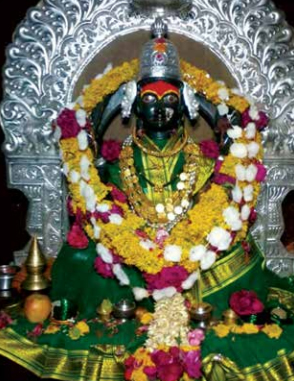
Over two hundred years from the time of Rājendrakīrti, the names of Jaina Kāsāras, in cities like Solapur and Kolhapur, have changed considerably. Yet in their middle names (usually of fathers for men) one finds such nonJaina names as Gajānana, Gaṇeśa, Gaṇapati, Paṇḍhari, Dattātreya, Śaṅkara, and Tukārāma, a practice of a past generation only.
Kāsāras
As the Baḷagaras (bangle-makers) of the tenth-century poet Ranna's time developed their skill in working in copper and bronze, mostly producing household utensils (pātra) and temple bells and so forth, they came to be known as Kāsāras (from Skt. kaṃsakāras), workers in copper or brass, bell-founders. They became wealthy merchants by the 19th century as testified by Bhaṭṭāraka Rājendrakīrti's letter. They were spread all over major cities of southern Maharashtra, from Pune/Kolhapur in the west, to Solapur/Mudhol in the east. The Śrī Pārśvanātha Kāsāra Jaina Mandira, in Shukravar Peth at Solapur, was established in ca. 1300 CE. Another major temple is in Kolhapur, called Śrī Candraprabha Digambara Jaina Kāsāra Mandira, distinguished by its images of the yakṣīs Jvālāmālinī, Padmāvatī, and most conspicuously, the Kālikādevī, discussed below. In addition to providing bhaṭṭārakas to the Malkhedpīṭha, the Kāsāra community has, in the last century, produced a number of Digambara munis in the lineage of Ācārya Śāntisāgara: Pāyasāgara, Vimalasāgara, Hemasāgara, Jayasena, Jayakīrti, and Anantakīrti.
Somavaṃśī Kṣatriya-Kāsāra
The legend of the lineage of Somavaṃśa (from Bāhubali, the second son of the first tīrthaṅkara Ṛṣabha) of the Kāsāras and their self-identity as being of the warrior (kṣatriya) jāti, probably derives from the early 18th- century Kālikā Purāṇa of Bhaṭṭāraka Devendrakīrti.[4]
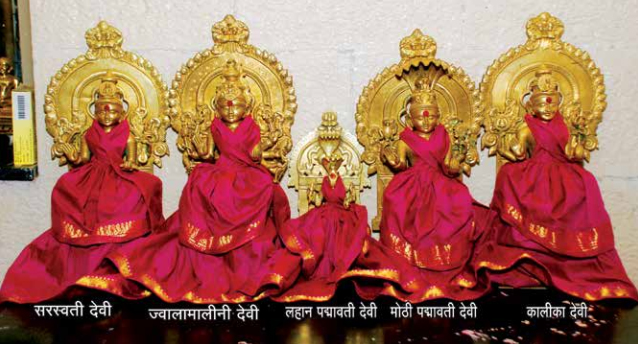
Figure 4. (left to right) Two images of Padmāvatī Yakṣī of Jina Pārśva (possibly identified with Kālī Yakṣī of Jina Supārśva) and an image of Kālikādevi=Kālī Yakṣī (of Supārśva Jina) at the Śrī Chandraprabha Digambara Jaina Kāsāra Mandira, Kāsāra Gali, Kolhapur. Photo courtesy of Suhas Duge.
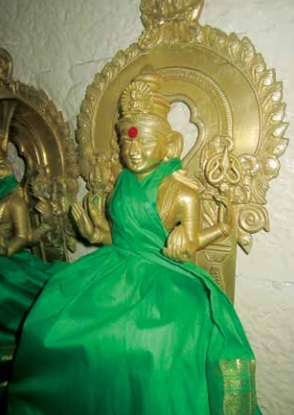
Figure 5. Close-up of the image of Kālikādevi=Kālī Yakṣī (of Supārśva Jina) (far-right image in figure 4) at the Śrī Candraprabha Digambara Jaina Kāsāra Mandira, Kāsāra Gali, Kolhapur. Photo courtesy of Suhas Duge.
Identity of the Goddess Kālikā Invoked at the Top of the Letter
Śrī Kālikādevī prasanna// śrī Padmāvatīdevī prasanna//
The bhaṭṭāraka invokes blessings of these two goddesses (devī) by placing them on the left and right side, respectively, at the head of the letter. Non-Jaina images of wholly vegetarian Kālikādevī are found in Maharashtra. (Figure 3) She is not widely known as a Jaina goddess and hence her presence here needs explanation. P.B. Desai (2001: 189) observes: "Icons at Malkhed stand in the temple of Pārśvanātha, in one side Dharaṇendra, in another Padmāvatī. The third image is that of Kālī, locally known as Kāḷammā. This should be identified with the Vidyādevī of the pantheon" (right upper: varada, right lower: khaḍga, left upper: shield, left lower: fruit).
Kālī Devī does appear in the list of vidyā-devis (Varni 1976: vol. 3, 552): Rohiṇī, Prajñapti, Vajraśṛṃkhalā, Vajrāṃkuśā, Jāmbūnādā, Puruṣadattā, Kālī, Mahākālī, Gaurī, Gāndhārī, Jvālāmālinī, Vairoṭī, Acyutā, Mānasī, Mahāmānasi. Pratiṣṭhāsāroddhāra 3/34-35. But Kālikā Devī was probably seen as a yakṣī, bearing not weapons but pāśa and ankuśa only in her two raised hands, by some bhaṭṭāraka of Malkhed. She was identified with Kālī-Yakṣī, of the 7th Jina Supārśva in Jaina tradition, according to the Indranandisaṃhitā (Shastri 2000: 81).[5] In the Śrī Candraprabha Digambara Jaina-Kāsāra Mandira at Kolhapur (ca. 1935) there are two devī images of special interest in tracing Kālikā Devī's progress to Kālī Yakṣī.
One image has on its head (not inside, but) in front of the crown, a seated medium size image of a Jina with a very small hood. (Figure 3 and Figure 4, far right) This image is called Kālī (=Kālikā) yakṣī [of SupārśvaJina]. The icon of Supārśva with a hood might have been modeled on the image of Pārśva. The second image is an imitation of the same. But it is distinguished by a hood above the small image of a Jina, and a much larger hood of a snake above the yakṣī's head. This I propose to be the image of the same Kālikā Devī/ Yakṣī, now possibly integrated with Padmāvatī Devī, the yakṣī of Jina Pārśvanātha.
Such integration might explain the statement made in the sixteenth-century Marathi metrical Kālikāpurāṇa (48 chapters, over 7000 ovī-s) that Kālikā Devī is the same as Devī Padmāvatī. The author of this purāṇa, Devendrakīrti, himself a Kāsāra Jaina, was a bhaṭṭāraka of Balātkāragaṇa at Latur (see Akkoḷe 1968: 7678). Akkoḷe does not seem to have been aware of the existence of the image of Kālikā Devī in the Kolhapur Kāsāra Jaina temple, but the existence of this image may substantiate Devendrakīrti's statement.
References
Akkoḷe, Subhāścandra. Pracīna Marāṭhī Jaina Sāhitya. Nāgpūr: Suvicār Prakāśan Maṇḍal, 1968 (pp. 7678).
Desai, P.B. Jainism in South India and Some Jain Epigraphs. Solapur: Jivaraj Jain Granthamala, 2nd ed., 2001.
Detige, Tillo. "The Bhaṭṭārakas of Kārañjā (Lāḍa): Triveṇī Saṅgama at Jaina Kāśī," pp. 14384. Sanmati, Essays in Honour of Professor Hampa Nagarajaiah. Ed. Luitgard Soni & Jayandra Soni. Bangalore: Sapna Book House, 2015.
Joharapurakar, Vidyadhara. Bhaṭṭāraka Sampradāya. Solapur: Jivarāj Jain Granthamālā, 1956.
Nagarajaiah, Hampa. Hombuja Śāsanagaḷu, Hombuja, 1997.
Nagarajaiah, Hampa. Koppaḷa Śāsanagaḷu, Mysore, 1998.
Nagarajaiah, Hampa (ed.) Ranna Sampuṭa, Hampi: Kannada Viśva Vidyālaya, 2006.
Premi, Nathuram. "Nandi-saṃghakī Gurvāvalī." Jaina Hitaiṣī 6, 78 (1921) (Reprinted in Premi 1956).
Premi, Nathuram. Jaina Sāhityakā Itihāsa. Bombay: Hindi Grantha Ratnakāra, 1956.
Sangave, Vilas. Jaina Community: A Social Survey. Bombay: Popular Prakashan, 1980
Shastri, Vardhaman Parśvanath. Jaina Dharmadalli Śāsanadevategaḷa Sthāna. Translated into Kannada by Dhanyakumar Jaini. Dharwad, 2000
Varni, Jinendra. Jainendra Siddhāntakośa. Bhāratīya Jñānapīṭha, Delhi, 1976
Padmanabh S. Jaini is Professor Emeritus of Buddhist Studies at the Department of South and Southeast Asian Studies, University of California, Berkeley.
I am indebted to Chandramohan Ratanchand Shah and Chandraneel Jaderia for the information in the Jaina Bodhaka as well as for the above quotation, which was verified from the records of the Humcha Maṭha.
I am indebted to Nemināth Śāstrī for providing me the following names of some prominent members of the Jaina Kāsāras in and around Kolhapur and Solapur: Pavan Jayakumār Bāgvāḍe, Manoj Bahirśeṭ, Rameś Civaṭe, Praśānt Dongare, Gajānan Bāburāo Dorle, Vilās Durugkar, Amar Bhūpāl Gargaṭṭe, Sambhājī Bābūrao Hajāre, Gaṇeś Candu Heravāḍe, Udaya Bābājī Jamadāḍhe, Pradīp Kāḍuskar, Śāntināth Gaṇapati Kāsār, Dilīp Śāntināth Khobre, Uday Lengaḍe, Madhukar Lokhaṇḍe, Ravikiraṇ Maindargi, Vasanta Baṇḍobā Māmlekar, Abhinandan Bāpusāheb Pokaḷe, Pradīpa Phalṭaṇe, Paṇḍhari Rājārām Mohare, Nemināth Candrakānt Nille, Padmākar Vidyādhar Rāngoḷe, Śrīkānt Dattātraya Rokaḍe, Vardhamān Śāntināth Ruikar, Mohan Śankar Sāḷavī, Anil Sāsavaḍe, Murlidhar Kisanlāl Sātapute, Māṇikarāo Tangā, Bharamā Tukārām Vaṇakudre, Vasant Dhoṇḍirām Vaṇakudre.
Cakreśvarī(1) Rohiṇī(2) ca Prajñaptir(3) Vajraśṛṃkhalā(4)/ Varadattā(5) Manovegā(6) Kālī(7) Jvālādimālinī(8)//Mahākālyabhidhā devī(9) devī Mānasikāhvayā(10)/ Gaurī(11) Gāndhārikā(12) devī devī Mānasikāhvayā(13)/tathāAnantamatī(14) Mānasī(15) Mahāmānasī(16) Jayā(17)//Vijayānyā(18) Aparājitā(19) Bahurūpiṇy(20) abhīṣṭhitā/ Cāmuṇḍākhyā(21) 'tha Kūṣmāṇḍī(22) Padmā(23) Siddhāyinīti(24)ca//
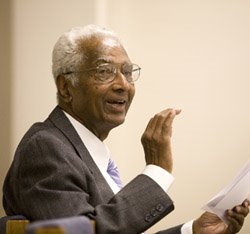 Padmanabh S. Jaini
Padmanabh S. Jaini